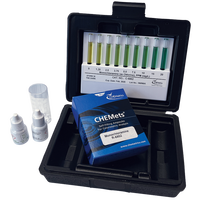Testing for Monochloramine

Testing for Monochloramine Water disinfection is a key step in water treatment for the wastewater and drinking water industries. Disinfection renders dangerous pathogens inert, preventing disease. While every water utility has its own method for disinfecting water, chlorine and mon
Monochloramine As A Disinfectant In Water
Water disinfection is a key step in water treatment for the wastewater and drinking water industries. Disinfection renders dangerous pathogens inert, preventing disease. While every water utility has its own method for disinfecting water, chlorine and monochloramine are two of the most common chemicals used for water disinfection. Many people are familiar with chlorine, but awareness of monochloramine is less common. While both chemicals are disinfectants, they are used in different capacities. In this post we will provide some basic information on monochloramine, how it is used, how it compares to chlorine, and how it is measured.
Testing for Monochloramine
Traditionally, monochloramine (NH2Cl) is measured using the N,N-diethyl-p-phenylenediamine (DPD) chemistry. To determine the concentration of monochloramine, the difference between two test results is calculated. The first test measures total or combined chlorine and is performed using DPD plus potassium iodide (KI). The second test measures free chlorine and employs DPD alone. By subtracting the free chlorine result from the total chlorine, an estimate of how much chloramine is in the solution is obtained. However, this measurement technique may overestimate the monochloramine concentration and, therefore, the disinfection status of the sample since the total chlorine DPD method measures all forms of chloramines, including organic amines, mono-, di- and trichloramine. To maintain efficient disinfection processes, a method of analysis that is specific to monochloramine is necessary.
What is Monochloramine?
Chloramines are a group of chemical compounds that contain ammonia and chlorine. Monochloramine (NH2Cl) is the simplest chemical compound of the chloramine group and as a result is often referred to as “chloramine.” Monochloramine is a colorless liquid that is soluble in water. It is commonly added to drinking water to function as a secondary disinfectant in a process called chloramination. Monochloramine is formed by the reaction of free ammonia (NH3 and NH4+) with free chlorine. Dichloramine (NHCl2) and trichloramine (NCl3) will also form if free chlorine remains in solution after all free ammonia has been converted to monochloramine. Dichloramine and trichloramine are less effective at disinfection and impart an unpleasant odor to the water. Therefore, chloramination processes are optimized for monochloramine production.
For Contract Chemical Manufacturing click here
